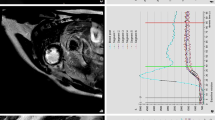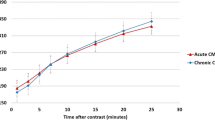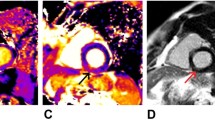Abstract
Purpose
The aim of our study was to evaluate the role of magnetic resonance (MR) imaging in identifying the location and extent of acute ischaemic injury to predict reversibility and distinguish areas of acute from chronic ischaemia in patients with acute coronary syndrome non- ST-elevation myocardial infarction (NSTEMI).
Materials and methods
We evaluated 22 patients with NSTEMI acute coronary syndrome confirmed by coronary angiography (CA). We studied ventricular function indices and segmental changes in wall thickness and kinetics by cine-MR imaging sequences. Subsequently, we evaluated myocardial wall oedema with T2-weighted black-blood short-tau inversion recovery turbo spin echo (T2 BB-STIRTSE) sequences and identified areas of myocardial necrosis using T1-weighted turbo field-echo inversion recovery (T1 TFE-IR) sequences after contrast material administration.
Results
The results obtained with the single sequences were as follows: T2 BB-STIR-TSE: 96.8% sensitivity, 100% specificity, 99.7% negative predictive value, 99.7% positive predictive value; T1 TFE-IR: 45.8% sensitivity, 96.9% specificity, 92.3% negative predictive value, 90.3% positive predictive value; systolic wall thickening: 87.5% sensitivity, 91.8% specificity, 98.7% negative predictive value, 50% positive predictive value, 91.4% accuracy.
Conclusions
Our study suggests that the sequences used for evaluating oedema and assessing viability allow for precise localisation and differentiation of areas of acute and chronic ischaemia by quantifying the possible mismatch between ischaemia and necrosis.
Riassunto
Obiettivo
L’obiettivo del nostro studio è di valutare la capacità della risonanza magnetica (RM) nell’identificare localizzazione ed estensione del danno ischemico acuto, nel predire la reversibilità del danno e nel distinguere fra aree ischemiche acute e croniche nei pazienti con ischemia miocardica senza elevazione del tratto ST (NSTEMI).
Materiali e metodi
Sono stati sottoposti ad esame cardio-RM 22 soggetti con sindrome coronarica acuta riconducibile ad un quadro di infarto NSTEMI, confermato all’esame coronarografico. Abbiamo studiato l’indice della funzione ventricolare e le alterazioni segmentarie dello spessore e della cinetica parietale ventricolare attraverso sequenze cine-RM. Abbiamo successivamente valutato edema parietale attraverso sequenze black-blood (BB) turbo spin echo (TSE) T2 (short tau inversion recovery [STIR]) ed aree miocardiche necrotiche mediante scansioni inversion recovery (IR) 3D turbo field echo (TFE) T1 pesate dopo iniezione di mezzo di contrasto (MdC).
Risultati
I risultati che abbiamo ottenuto sono stati: BB TSE T2w (STIR): sensibilità 96,8%, specificità 100%, valore predittivo negativo (VPN) 99,7%, valore predittico positivo (VPP) 99,7%; IR TFE T1w: sensibilità 45,8%, specificità 96,9%, VPN 92,3%, VPP 90,3%; ispessimento parietale sistolico: sensibilità 87,5%, specificità 91,8%, VPN 98,7%, VPP 50%, accuratezza 91,4%.
Conclusioni
Il nostro studio ha dimostrato che le sequenze per la valutazione della vitalità miocardica e quelle per l’identificazione dell’edema consentono una precisa localizzazione e differenziazione delle aree ischemiche acute dalle croniche, quantificando il mismatch ischemia/necro.
Similar content being viewed by others
References/Bibliografia
Buja LM, Hagler HK, Willerson JT (1988) Altered calcium homeostasis in the pathogenesis of myocardial ischemic and hypoxic injury. Cell Calcium 9:205–217
Dorr R (2008) Acute coronary syndrome-a challenge for the cooperation between outpatient and inpatient care. Herz 33:395–401
Buja LM (1998) Modulation of the myocardial response to ischemia. LabInvest 78:1345–1373
Reimer KA, Jennings RB (1979) The “wavefront phenomenon” of myocardial ischemic cell death: II. Transmural progression of necrosis within the framework of ischemic bed size (myocardium at risk) and collateral flow. Lab Invest 40:633–644
Reimer KA, Ideker RE (1987) Myocardial ischemia and infarction: anatomic and biochemical substrates for ischemic cell death and ventricular arrhythmias. Hum Pathol 18:462–475
Park JL, Lucchesi BR (1998) Mechanisms of myocardial reperfusion injury. Ann Thorac Surg;68:1905–1912
Braunwald E, Rutherford JD (1986) Reversible ischemic left ventricular dysfunction: evidence for the “hibernating myocardium”. J Am Coll Cardiol 8:1467–1470
Mills I, Fallon JT, Wrenn D et al (1994) Adaptative responses of coronary circulation and myocardium to chronic reduction in perfusion pressure and flow. Am J Physiol Heart Circ Physiol 266:H447–H457
Mewton N, Bonnefoy E, Revel D et al (2009) Presence and extent of cardiac magnetic resonance microvascular obstruction in reperfused non-ST-eleveted myocardial infarction and correlation with infarct size and myocardial enzyme release. Cardiology 113:50–58
Meluzin J, Cerny J, Frelich M et al (1998) Prognostic value of the amount of dysfunctional but viable myocardium in revascularised patients with coronary artery disease and left ventricular dysfuntion. J Am Coll Cardiol 32:912–920
Selvanayagam JB, Kardos A, Francis JM et al (2004) Value of delayedenhancement cardiovascular magnetic resonance imaging in predicting myocardial viability after surgical revascularization. Circulation 110:1535–1541
Kim RJ, Fieno DS, Parrish TB et al (1999) Relationship of MRI delayed contrast enhancement to irreversible injury, infarct age and contractile function. Circulation 100:1992–2002
Fieno DS, Kim RJ, Chen EL et al (2000) Contrast-enhanced magnetic resonance imaging of myocardium at risk: distinction between reversible and irreversible injury throughout infarct healing. J Am Coll Cardiol 36:1985–1991
Plein S, Younger JF, Sparrow P et al (2008) Cardiovascular magnetic resonance of scare and ischemia burden early after acute ST elevation myocardial infarction. J Cardiovasc Magn Reson 10:47
American Heart Association (AHA) (2006) Heart disease and stroke statistic — Update
Braunwald E, Antman EM, Beasley JW et al (2000) ACC/AHA guidelines for the management of patients with unstable angina and non-ST-segment elevation myocardial infarction. J Am Coll Cardiol 36:970–1062
Braunwald E, Antman EM, Beasley JM et al (2002) American College of Cardiology/American Heart Association Task Force on Practice Guidelines (Committee on the Management of Patients with Unstable Angina). ACC/AHA 2002 guidelines update for the management of patients with unstable angina and non -ST-segment elevation myocardial infarction: summary article: A Task Force on Practice Guidelines (Committee on the Management of Patients with Unstable Angina). Circulation 106:1893–1900
Hombach V, Merkle N, Kestler HA et al (2008) Characterization of patient with acute chest pain using magnetic resonance imaging. Clin Res Cardiol 97:760–767
Hendel RC, Patel MR, Kramer CM, Poon M (2006) ACCF/ACR/SCCT/SCMR/ASNC/NAS CI/SCAI/SIR 2006 appropriateness criteria for cardiac computed tomography and cardiac magnetic resonance imaging: a report of the American College of Cardiology Foundation/American College of Radiology, Society of Cardiovascular Computed Tomography, Society for Cardiovascular Magnetic Resonance, American Society of Nuclear Cardiology, North American Society for Cardiac Imaging, Society for Cardiovascular Angiography and Interventions, and Society of Interventional Radiology. J Am Coll Cardiol 48:1475–1497
Cerqueira MD, Weissman NJ, Dilsizian V et al (2002) Standardized myocardial segmentation and nomenclature for tomographic imaging of the heart: a statement for healthcare professionals from the Cardiac Imaging Committee of the Council on Clinical Cardiology of the American Heart Association. Circulation 105:539–542
Jennings RB, Schaper J, Hill ML (1985) Effect of reperfusion late in the phase of reversible ischemic injury. Changes in cell volume, electrolytes, metabolites, and ultrastructure. Circ Res 56:262–278
Garcia-Dorado D, Oliveras J, Gili J et al (1993) Analysis of myocardial oedema by magnetic resonance imaging early after coronary artery occlusion with or without reperfusion. Cardiovasc Res 27:1462–1469
Whalen DA Jr, Hamilton DG, Ganote CE, Jennings RB (1974) Effect of a transient period of ischemia on myocardial cells. I. Effe cts on cell volume regulation. Am J Pathol 74:381–397
Ligabue G, Fiocchi F, Ferraresi S et al (2008) 3 Tesla MRI for evaluation of myocardial viability: a comparative study with 1.5-Tesla MRI. Radiol Med 113:347–362
Dymarkowski S, Ni Y, Miao Y et al (2002) Value of T2 -weighted magnetic resonance imaging early after myocardial infarction in dogs: comparison with bis-gadoliniummesoporphyrin enhanced T1 —weighted mag-netic resonance imaging and functional data from cine magnetic resonance imaging. Invest Radiol 37:77–85
Miller S, Helber U, Kramer U et al (2001) Subacute myocardial infarction: assessment by STIR T2 -weighted MR imaging in comparison to regional function. Magma 13:8–14
Abdel-Aty H, Zagrosek A, Schulz-Menger J et al (2004) Delayed enhancement and T2-weighted cardiovascular magnetic resonance imaging differentiate acute from chronic myocardial infarction. Circulation 109:2411–2416
Mahrholdt H, Wagner A, Holly TA et al (2002) Reproducibility of chronic infarct size measurement by contrastenhanced magnetic resonance imaging. Circulation 106:2322–2327
Pereira RS, Prato FS, Sykes J et al (1999) Assessment of myocardial viability using MRI during a constant infusion of Gd-DTPA: further studies at early and late periods of reperfusion. Magn Reson Med 42:60–68
Schulz-Menger J, Gross M, Messroghli D et al (2003) Cardiovascular magnetic resonance of acute myocardial infarction at a very early stage. J Am Coll Cardiol 42:513–518
Johnston DL, Brady TJ, Ratner AV et al (1985) Assessment of myocardial ischemia with proton magnetic resonance: effects of a three hour coronary occlusion with and without reperfusion. Circulation 71:595–601
Stork A, Muellerleile K, Bansmann PM et al (2007) Value of T2-weighted, first-pass and delayed enhancement, and cine CMR to differentiate between acute and chronic myocardial infarction. Eur Radiol 17:610–617
Scholz TD, Fleagle SR, Burns TL et al (1989) Tissue determinants of nuclear magnetic resonance relaxation times: effect of water and collagen content in muscle and tendon. Invest Radiol 24:893–898
Laissy JP, Hyafil F, Feldman LJ et al (2005) Differentiating acute myocardial infarction from myocarditis: diagnostic value of early and delayed-perfusion cardiac MR imaging. Radiology 237:75–82
Lardo AC, Cordiero MA, Silva C et al (2006) Contrast-enhanced multidetector computer tomography viabilità imaging after miocardial infarcation: characterization of myocite death, mycrovascular obstruction, and chronic scar. Circulation 113:394–404
Author information
Authors and Affiliations
Corresponding author
Rights and permissions
About this article
Cite this article
Romagnoli, A., Sperandio, M., Di Roma, M. et al. Anatomical and functional evaluation of the myocardium in patients with acute coronary syndrome (NSTEMI) using MR imaging. Radiol med 116, 163–177 (2011). https://doi.org/10.1007/s11547-010-0609-x
Received:
Accepted:
Published:
Issue Date:
DOI: https://doi.org/10.1007/s11547-010-0609-x




